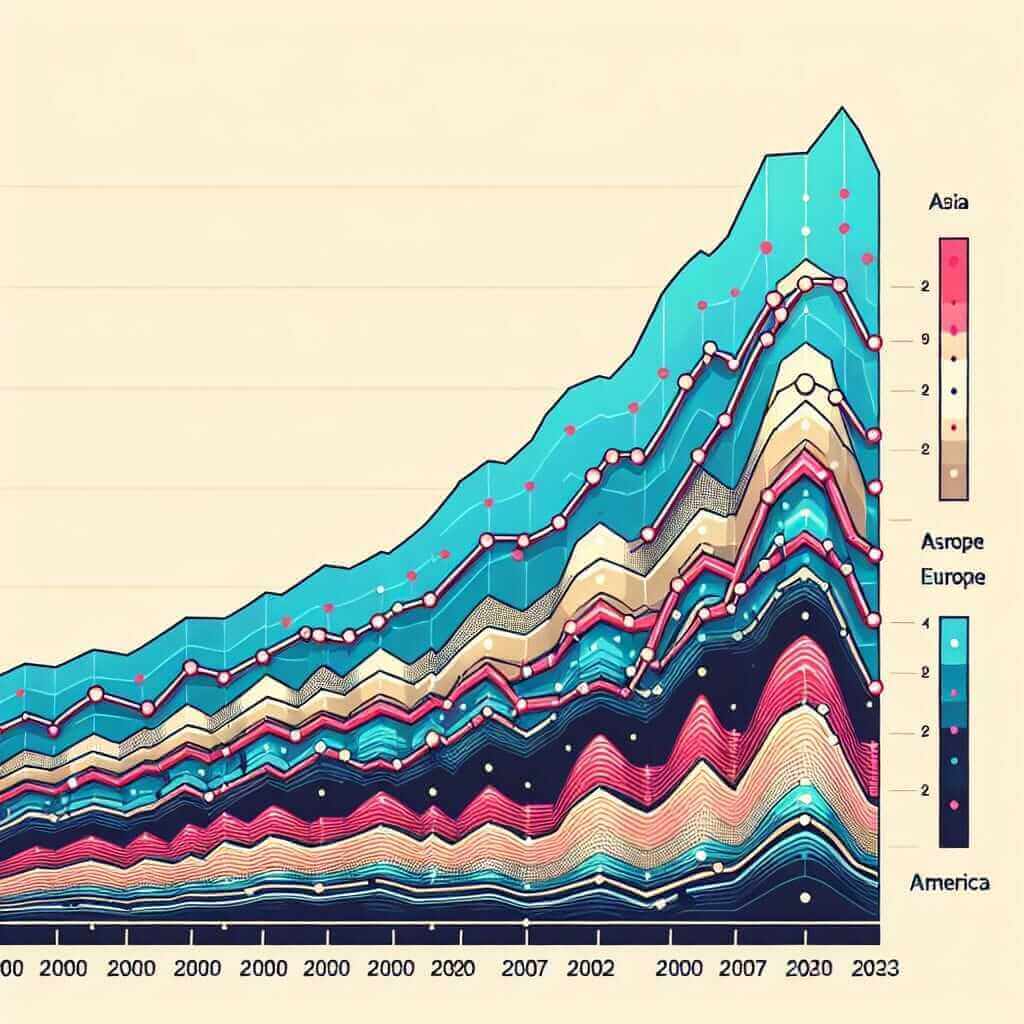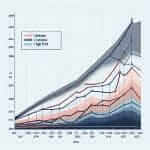Understanding how to compare different data sets effectively is a crucial skill for IELTS Writing Task 1. In the context of comparing levels of internet access in various regions from 2000 to 2023, this topic not only provides a comprehensive look into global digital trends but also offers a rich data set to practice descriptive and comparative writing skills.
Introduction
In the IELTS Writing Task 1, it is common to encounter tasks involving comparisons of different sets of data. The topic “Comparing Levels of Internet Access in Different Regions (2000-2023)” fits this pattern perfectly. You may be asked to describe trends, compare statistics, and summarize information accurately.
Example IELTS Task
Here are a few sample tasks based on our topic:
- Task 1: The line graph below shows the percentage of internet access in three different regions (Asia, Europe, and America) from 2000 to 2023. Summarize the information by selecting and reporting the main features and make comparisons where relevant.
- Task 2: The bar chart illustrates the growth in internet access rates in five regions (Africa, Asia, Europe, Latin America, and North America) from 2000 to 2023. Summarize the information by selecting and reporting the main features and make comparisons where relevant.
- Task 3: Compare the levels of internet access in different continents from 2000 to 2023 as shown in the table below. Summarize the information by selecting and reporting the main features and make comparisons where relevant.
For this guide, we will choose the first task related to the line graph.
Main Content
Selected Task
Task 1: The line graph below shows the percentage of internet access in three different regions (Asia, Europe, and America) from 2000 to 2023. Summarize the information by selecting and reporting the main features and make comparisons where relevant.
Generating the Data
To create a realistic example, here is an illustrative line graph summarizing the provided data:
| Year | Asia (%) | Europe (%) | America (%) |
|------|----------|------------|-------------|
| 2000 | 5 | 20 | 35 |
| 2005 | 20 | 40 | 55 |
| 2010 | 40 | 60 | 70 |
| 2015 | 60 | 80 | 85 |
| 2020 | 70 | 90 | 90 |
| 2023 | 75 | 95 | 95 | Internet Access Trends (2000-2023)
Internet Access Trends (2000-2023)
Analyzing the Task
Introduction: Briefly introduce what the graph shows.
The provided line graph illustrates the change in internet access across Asia, Europe, and America from 2000 to 2023.
Overview: Summarize the main trends.
Overall, all three regions have seen a significant increase in internet access over the given period, with Europe leading, followed by America and Asia.
Details: Provide a detailed description, including comparisons and key points.
From 2000 to 2005, internet access in Asia rose from 5% to 20%, a fourfold increase. In the same period, Europe saw an increase from 20% to 40%, while America grew from 35% to 55%. This initial phase reflects rapid growth in all regions.
From 2005 to 2010, the upward trend continued with Asia jumping to 40%, Europe rising to 60%, and America reaching 70%. The trend shows that despite starting with the lowest percentage, Asia showed the most rapid percentage growth.
Between 2010 and 2015, internet access in Asia jumped to 60%, while Europe and America saw growths to 80% and 85%, respectively. This trend demonstrates a steady convergence among the regions, with Europe and America maintaining a lead over Asia.
From 2015 to 2020, Asia reached 70%, while Europe and America both achieved 90% internet access. By 2023, all regions have nearly equalized with Asia at 75%, and both Europe and America at 95%.
Sample Answer
The line graph illustrates the percentage of internet access in Asia, Europe, and America from the year 2000 to 2023, demonstrating a general upward trend in all three regions.
From 2000 to 2005, internet access in Asia increased from 5% to 20%, representing a fourfold growth. In the same period, Europe and America saw increases from 20% to 40% and from 35% to 55%, respectively, marking substantial growth in each region.
The subsequent five years (2005-2010) continued to see significant rises. Asia’s percentage doubled from 20% to 40%, Europe moved up to 60%, and America reached 70%. This period showcased the most rapid growth in Asia in terms of percentage increase.
During the years 2010 to 2015, internet access in Asia surged to 60%, while Europe and America reached 80% and 85% respectively. The data suggests that although Asia started with the lowest percentage, it showed strong growth.
From 2015 to 2020, the trend continued as Asia reached 70%, while both Europe and America attained 90% access rates. By 2023, Asia’s internet usage grew to 75%, closing in on Europe and America, each reaching 95%.
In summary, over the period from 2000 to 2023, all regions experienced remarkable growth in internet penetration, with Europe consistently leading, followed closely by America and then Asia.
Word count: 221
Key Considerations
- Tense Consistency: Use past tenses when describing historical data. E.g., “saw,” “increased,” and “rose.”
- Comparative Language: Use comparative structures to show differences and similarities. E.g., “higher than,” “the same as,” “more than.”
- Linking Words: Use linking words to create a natural flow in your writing. E.g., “while,” “meanwhile,” “and,” “however,” “in summary.”
Key Vocabulary
- Surge (verb) /səːdʒ/: a sudden powerful forward or upward movement.
- Leap (verb) /liːp/: to jump or make a large increase.
- Soar (verb) /sɔː/: fly or rise high in the air.
- Level off (phrasal verb): stay at a steady level after a period of sharp increase.
- Outstrip (verb) /aʊtˈstrɪp/: move faster or be more successful than others.
- Gradual (adj) /ˈɡrædʒuəl/: taking place or progressing slowly or by degrees.
- Exponential (adj) /ˌekspəˈnenʃl/: increasing rapidly.
- Convergence (noun) /kənˈvɜːdʒəns/: the process of coming together.
Conclusion
In IELTS Writing Task 1, one must meticulously describe data trends, make comparisons, and summarize information cohesively. For achieving a Band 7+, ensure clarity, coherence, and precise use of language. Practice with realistic and varied data sets to hone your skills further.


